Why Do Fingers Get Pruney When Wet? An Evolutionary Wrinkle!

Why do our fingers and toes get pruney when they're wet? For a long time, people assumed it happened for no particular reason that our skin simply soaks up water like a sponge in a random pattern. However, showing once again that few evolved traits are useless, recent research has revealed wet-induced wrinkles' deeper purpose.
A group of scientists at 2AI Labs, an independent research institution in Idaho that focuses on human cognition and evolution, noticed some puzzling facts about finger and toe pruneyness: Water only wrinkles the tips of our digits, and nowhere else on the body, so it cannot be a simple side effect of skin's water absorbency. Moreover, previous observations have revealed that nerve damage in fingers prevents the formation of the wrinkles, suggesting that the nervous system controls their formation, not water.
In a paper the group published June 23 in the journal Brain, Behavior and Evolution, the researchers, led by neurobiologist Mark Changizi, argued that the wrinkles are "rain treads": They are a neural response that evolved to allow the efficient removal of water from the pads of our fingers and toes, thereby improving our grip in wet conditions.
"We worked out what the qualitative nature of the wrinkles should be like if they really are water drainage networks, and then showed that pruney fingers have that signature (...rather than infinitely many other sorts of wrinkle patterns that could potentially exist)," Changizi told Life's Little Mysteries. [Do Identical Twins Have Identical Fingerprints? ]
As seen in the picture above, wet-induced wrinkles (on the authors' own fingers) look very similar to water drainage networks on mountain promontories.
"In addition to wet-induced finger wrinkles having the signature morphology of drainage networks, the time scale at which they appear (around 5 min) ... is plausibly appropriate for natural wet conditions; it is fast enough to be relevant for dew or rainy conditions but not so quick that casual contact with water (like when eating fruit) will elicit it," the researchers wrote in their paper.
In a pilot study not yet published, the team found that humans' ability to grip heavy objects does indeed improve after our wet fingers have developed wrinkles, as compared to before. Someday, traction-improving channels like those on our fingers and mountain rivulets might inspire the grooves patterned into human footwear.
Sign up for the Live Science daily newsletter now
Get the world’s most fascinating discoveries delivered straight to your inbox.
The next step in finger prune research will be determining which primates do and do not possess the trait. "One would like to be able to predict which sorts of animals are expected to be pruney, and which are not. [For example], do wetter species have more pruneyness?" Changizi wrote in an email.
"At the moment, though, we have almost no data on which animals do and do not have prunes. I did find that macaques get pruney, which suggests all Old World monkeys probably do. But we need to have a lot more I asked more than dozen primate labs, and none had ever looked to see."
Follow Natalie Wolchover on Twitter @nattyover. Follow Life's Little Mysteries on Twitter @llmysteries, then join us on Facebook.
Natalie Wolchover was a staff writer for Live Science from 2010 to 2012 and is currently a senior physics writer and editor for Quanta Magazine. She holds a bachelor's degree in physics from Tufts University and has studied physics at the University of California, Berkeley. Along with the staff of Quanta, Wolchover won the 2022 Pulitzer Prize for explanatory writing for her work on the building of the James Webb Space Telescope. Her work has also appeared in the The Best American Science and Nature Writing and The Best Writing on Mathematics, Nature, The New Yorker and Popular Science. She was the 2016 winner of the Evert Clark/Seth Payne Award, an annual prize for young science journalists, as well as the winner of the 2017 Science Communication Award for the American Institute of Physics.
Most Popular


